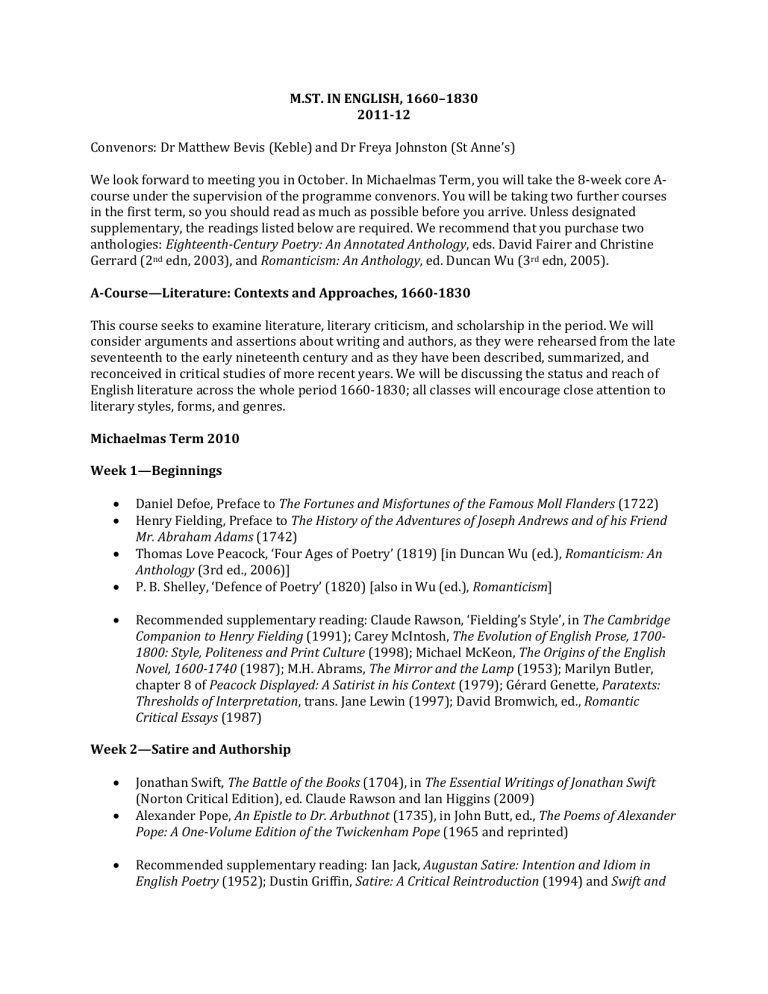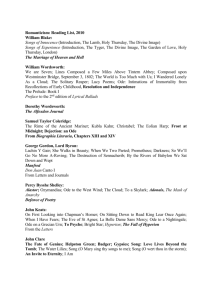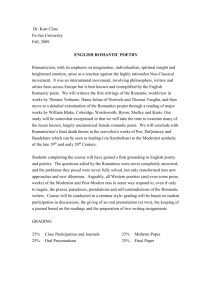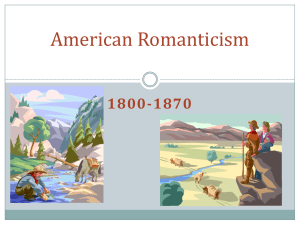M.St. in English, 1660–1830 2011-12 Convenors: Dr Matthew Bevis

M.ST. IN ENGLISH, 1660–1830
2011-12
Convenors: Dr Matthew Bevis (Keble) and Dr Freya Johnston (St Anne’s)
We look forward to meeting you in October. In Michaelmas Term, you will take the 8-week core Acourse under the supervision of the programme convenors. You will be taking two further courses in the first term, so you should read as much as possible before you arrive. Unless designated supplementary, the readings listed below are required. We recommend that you purchase two anthologies: Eighteenth-Century Poetry: An Annotated Anthology, eds. David Fairer and Christine
Gerrard (2 nd edn, 2003), and Romanticism: An Anthology, ed. Duncan Wu (3 rd edn, 2005).
A-Course—Literature: Contexts and Approaches, 1660-1830
This course seeks to examine literature, literary criticism, and scholarship in the period. We will consider arguments and assertions about writing and authors, as they were rehearsed from the late seventeenth to the early nineteenth century and as they have been described, summarized, and reconceived in critical studies of more recent years. We will be discussing the status and reach of
English literature across the whole period 1660-1830; all classes will encourage close attention to literary styles, forms, and genres.
Michaelmas Term 2010
Week 1—Beginnings
Daniel Defoe, Preface to The Fortunes and Misfortunes of the Famous Moll Flanders (1722)
Henry Fielding, Preface to The History of the Adventures of Joseph Andrews and of his Friend
Mr. Abraham Adams (1742)
Thomas Love Peacock, ‘Four Ages of Poetry’ (1819) [in Duncan Wu (ed.), Romanticism: An
Anthology (3rd ed., 2006)]
P. B. Shelley, ‘Defence of Poetry’ (1820) [also in Wu (ed.), Romanticism]
Recommended supplementary reading: Claude Rawson, ‘Fielding’s Style’, in The Cambridge
Companion to Henry Fielding (1991); Carey McIntosh, The Evolution of English Prose, 1700-
1800: Style, Politeness and Print Culture (1998); Michael McKeon, The Origins of the English
Novel, 1600-1740 (1987); M.H. Abrams, The Mirror and the Lamp (1953); Marilyn Butler, chapter 8 of Peacock Displayed: A Satirist in his Context (1979); Gérard Genette, Paratexts:
Thresholds of Interpretation, trans. Jane Lewin (1997); David Bromwich, ed., Romantic
Critical Essays (1987)
Week 2—Satire and Authorship
Jonathan Swift, The Battle of the Books (1704), in The Essential Writings of Jonathan Swift
(Norton Critical Edition), ed. Claude Rawson and Ian Higgins (2009)
Alexander Pope, An Epistle to Dr. Arbuthnot (1735), in John Butt, ed., The Poems of Alexander
Pope: A One-Volume Edition of the Twickenham Pope (1965 and reprinted)
Recommended supplementary reading: Ian Jack, Augustan Satire: Intention and Idiom in
English Poetry (1952); Dustin Griffin, Satire: A Critical Reintroduction (1994) and Swift and
Pope: Satirists in Dialogue (2010); Joseph M. Levine, Between Ancients and Moderns: Baroque
Culture in Restoration England (1999); Catherine Ingrassia, Authorship, Commerce and
Gender in Early Eighteenth-Century England: A Culture of Paper Credit (1998); Pat Rogers,
Hacks and Dunces: Pope, Swift, and Grub Street (1980); Pat Rogers, ‘A Drama of Mixed
Feelings: the Epistle to Arbuthnot’, in Essays on Pope (1993); Helen Deutsch, ‘Pope, Self, and
World’, in The Cambridge Companion to Alexander Pope, ed. Pat Rogers (2007); Brean
Hammond, The Rise of Professional Imaginative Writing in England, 1670-1740: Hackney for
Bread (1997)
Week 3—Public and Private Landscapes
Thomas Gray, Elegy Written in a Country Churchyard (1751), in The Poems of Gray, Collins
and Goldsmith, ed. Roger Lonsdale (Longman, 1969)
William Wordsworth, ‘Lines Written a Few Miles Above Tintern Abbey, on Revisiting the
Banks of the Wye during a Tour, July 13 th , 1798’, Lyrical Ballads (1798)
William Wordsworth, Preface to Lyrical Ballads (1800, 1802) [multiple good edns: Oxford
World’s Classics Major Works; Broadview Lyrical Ballads, ed. M. Gamer & D. Porter (2008);
Oxford Prose Works, ed. W.J.B. Owen & J.W. Symser (1974), vol. 1; Wordsworth’s Literary
Criticism, ed. Owen (1974); Cornell ed. of Lyrical Ballads, ed. J. Butler & K. Green (1992)]
Recommended supplementary reading: William Empson, Some Versions of Pastoral
(Hogarth Press, 1986 and reprinted), ch. 1: ‘Proletarian Literature’; Vincent Newey, ‘The
Selving of Thomas Gray’, Paul Williamson, ‘Gray’s Elegy and the Logic of Expression’, and
Richard Terry, ‘Gray and Poetic Diction’, in Thomas Gray: Contemporary Essays, eds. W. B.
Hutchings and William Ruddick (1993); John Barrell, English Literature in History 1730-80:
An Equal, Wide Survey (1983); John Sitter, Literary Loneliness in Mid-Eighteenth-Century
England (1982); Charles J. Rzepka, ‘Pictures of the Mind: Iron and Charcoal, “Ouzy” Tides and “Vagrant Dwellers” at Tintern, 1798’, Studies in Romanticism 42 (2003), 155-85; David
Bromwich, Disowned By Memory: Wordsworth’s Poetry of the 1790s, chapter 3 (2000)
Week 4—The Essay
Joseph Addison, The Spectator no. 10 (1711)
David Hume, ‘Of Essay-Writing’ (1742)
Samuel Johnson, The Rambler no. 2 (1750)
William Hazlitt, ‘On Reading Old Books’ in The Plain Speaker (1821), ‘On Familiar Style’, in
Table Talk (1821-22), ‘The Letter-Bell’, in The Monthly Magazine (1831)
Charles Lamb, ‘Imperfect Sympathies’, ‘The Old and the New Schoolmaster’, and ‘Detached
Thoughts on Books and Reading’ in Essays of Elia (1823)
Recommended supplementary reading: Denise Gigante, ed., The Great Age of the English
Essay (2008); W. K. Wimsatt, The Prose Style of Samuel Johnson (1941); Thomas McFarland,
Romantic Cruxes: The English Essayists and the Spirit of the Age (1987); David Bromwich,
Hazlitt: The Mind of a Critic (1983) and introduction to David Bromwich, ed., Romantic
Critical Essays (1987); Tom Paulin, The Day-Star of Liberty: William Hazlitt’s Radical Style
(1998); Adam Phillips, ed., introduction to Charles Lamb: Selected Prose (1985); Carl H.
Klaus, The Made-up Self: Impersonation in the Personal Essay (2010)
Week 5—Oddity and Longevity: Laurence Sterne
The Life and Opinions of Tristram Shandy, Gentleman (1759-67)—Penguin Classics edition, ed. Melvyn New and Joan New (2003)
Recommended supplementary reading: Thomas Keymer, Sterne, the Moderns, and the Novel
(2002); Thomas Keymer, ed., Laurence Sterne’s Tristram Shandy: A Casebook (2006);
Thomas Keymer, ‘Sterne and Romantic Autobiography’, in The Cambridge Companion to
English Literature 1740-1830 (2004); Ian Campbell Ross, Laurence Sterne: A Life (2001);
David A. Brewer, The Afterlife of Character, 1726-1825 (2005), ch. 5; John Mullan, Sentiment
and Sociability: The Language of Feeling in the Eighteenth Century, ch. 4 (1988); Fred Parker,
Scepticism and Literature: An Essay on Pope, Hume, Sterne and Johnson (2003); Melvyn New, ed., Tristram Shandy: Contemporary Critical Essays (1992)
Week 6—Waxing Lyrical
William Collins, ‘Ode on The Poetical Character’
Thomas Gray, ‘The Bard: A Pindaric Ode’
William Wordsworth, ‘Ode: Intimations of Immortality’, ‘The Solitary Reaper’
Percy Bysshe Shelley, ‘Ode to the West Wind’, ‘Hymn to Intellectual Beauty’
John Keats, ‘Ode to a Nightingale’, ‘Ode on a Grecian Urn’, ‘To Autumn’
John Clare, ‘I am’
[many of these poems are in Wu., ed. Romanticism]
Recommended supplementary reading: W. R. Johnson, The Idea of Lyric (1982); M. H.
Abrams, ‘Structure and Style in the Greater Romantic Lyric’, in The Correspondent Breeze:
Essays on English Romanticism (1984); Stuart Curran, ‘The Hymn and The Ode’ in Poetic
Form and British Romanticism (1986); Chaviva Hosek and Patricia Parker, eds., Lyric Poetry:
Beyond The New Criticism (1985); Helen Vendler, The Odes of John Keats (1983); Paul H. Fry,
The Poet’s Calling in the English Ode (1980); Michael O’Neill, Romanticism and The Self-
Conscious Poem (1997); Susan Wolfson, Formal Charges: The Shaping of Poetry in British
Romanticism (1997); J. H. Prynne, Field Notes: ‘The Solitary Reaper’ and Others (2007)
Week 7—Corresponding Forms
Frances Burney, Evelina; or the History of a Young Lady’s Entrance into the World (1778), eds. Vivien Jones and Edward Bloom (Oxford World’s Classics)
Jane Austen, ‘The Three Sisters’, ‘Love and Freindship’, ‘Lady Susan’, in Juvenilia, ed. Peter
Sabor (Cambridge UP)
Recommended supplementary reading: Betty Schellenberg, The Professionalization of
Women Writers in Eighteenth-Century England (2009), ch. 6; Jane Spencer, Literary
Relations: Kinship and the Canon 1660-1830 (2005), ch. 1; John Bayley, ‘The
“Irresponsibility” of Jane Austen’, in B. C. Southam, ed., Critical Essays on Jane Austen (1968);
Norman Page, The Language of Jane Austen (1972); Bharat Tandon, Jane Austen and the
Morality of Conversation (2003); J. David Grey, ed., Jane Austen’s Beginnings: The Juvenilia
and Lady Susan (1989)
Week 8—Heroism, Mock-Heroic, Mock-Epic
Alexander Pope, The Rape of The Lock (1714)
George Gordon, Lord Byron, Don Juan, Cantos I & II (1821) – in e.g. Wu, ed., Romanticism
Recommended supplementary reading: David Fairer, English Poetry of the Eighteenth
Century (2002), ch. 3; Richard Terry, Mock-Heroic from Butler to Cowper: An English Genre
and Discourse (2005); Claude Rawson, Satire and Sentiment 1660-1830 (2000), chs. 3-5;
Ritchie Robertson, Mock-Epic Poetry from Pope to Heine (2009); Jerome McGann, Don Juan in
Context (1976); Anne Barton, Byron: Don Juan (1992); Jane Stabler, Byron, Poetics and
History (2002); W. H. Auden, ‘Don Juan’, in The Dyer’s Hand (1968)
General reading and useful reference works:
M. H. Abrams, The Mirror and the Lamp: Romantic Theory and the Critical Tradition (1953)
Walter Jackson Bate, From Classic to Romantic: Premises of Taste in Eighteenth-Century England
(1946)
Marilyn Butler, Romantics, Rebels and Reactionaries: English Literature and Its Background 1760-
1830 (1981)
William Doyle, The French Revolution: A Very Short Introduction (2001)
Marilyn Gaull, English Romanticism: The Human Context (1988)
James Sambrook, The Eighteenth Century: The Intellectual and Cultural Context (1993)
W. A. Speck, Literature and Society in Eighteenth-Century England: Ideology, Politics and Culture,
1680-1820 (1998)
Paul Langford, A Polite and Commercial People: England 1727-83 (Oxford University Press, 1989)
Iain McCalman, ed., An Oxford Companion to the Romantic Age: British Culture 1776-1832 (1999)
Seamus Perry, Coleridge and The Uses of Division (1999)
David Womersley ed., A Companion to Literature from Milton to Blake (Blackwell, 2000)
Duncan Wu., ed., A Companion to Romanticism (1999)








